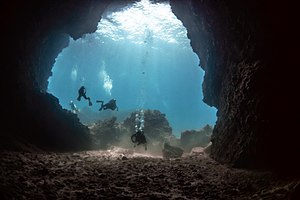Mu Ko Lanta National Park
| Mu Ko Lanta National Park | |
|---|---|
| อุทยานแห่งชาติหมู่เกาะลันตา | |
|
IUCN category II (national park)
|
|

Underwater cave in the park
|
|
|
Map of Thailand
|
|
| Location | Krabi Province, Thailand |
| Coordinates | 7°29′02″N 99°05′56″E / 7.484°N 99.099°ECoordinates: 7°29′02″N 99°05′56″E / 7.484°N 99.099°E |
| Area | 134 km2 (52 sq mi) |
| Established | 1990 |
| Website | |
Mu Ko Lanta National Park (Thai: อุทยานแห่งชาติหมู่เกาะลันตา) is a national park in the southern part of Krabi Province, Thailand, consisting of several islands. The two largest islands are Ko Lanta Noi and Ko Lanta Yai. Although both are inhabited, Ko Lanta Yai is the primary tourist destination. The park was established in 1990.
A clan of Chao Ley, or "sea gypsies" lives on Ko Lanta Yai. The clan still practices many of their ancient customs and ceremonies, such as the setting of ceremonial boats adrift to bring good luck and prosperity on the full moon nights of the sixth and eleventh months.
Ko Lanta was once known by its Malay name, "Pulao Satak", which means "Long Beach Island". Later, many Thais, both Buddhist and Muslim, moved to the island making the island known as the island of "a million eyes" ("lan ta" in Thai). The name may also be derived from the Javanese "lan-tas", or fish grill (built of wood with a square grill on top where the fish are placed in a circle).
The area of Mu Ko Lanta National Park is 134 km2 (83,750 rai. It includes Mu Ko Rok, Ko Mai Ngam, Ko Talabeng, Ko Lanta Yai, Ko Ngai, Mu Ko Rokk, Ko Rok Nai, Mu Ko Maa, Ko Hin Dang and the nearby islands of Ko Klang, Ko Lanta Noi, and Ko Lanta Yai sub-district, Amphoe Ko Lanta, Krabi Province.
The terrain is mountainous, especially near the southern tip. Plains are found only in beach areas in the southern portion of the park. Most areas have more than a 35 degree slope, except only the middle part of island where the slope is more than 50 degrees. Elevations range from sea level to 488 meters at the tallest peak.
Highest rainfall is in September, 391.4 mm, and lowest in January at 6.5 mm. September has the most rainy days with 21.6 days and February the fewest, about 1.6 days. During the rainy season, 16 May-31 October, some smaller islands are closed to visitors.
...
Wikipedia

